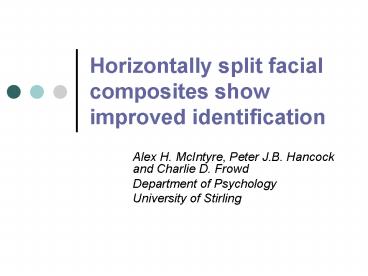Horizontally split facial composites show improved identification PowerPoint PPT Presentation
1 / 21
Title: Horizontally split facial composites show improved identification
1
Horizontally split facial composites show
improved identification
- Alex H. McIntyre, Peter J.B. Hancock and Charlie
D. Frowd - Department of Psychology
- University of Stirling
2
Facial Composites
- Images produced by combining separate facial
features. - Created with sophisticated software that are
capable of generating very good likenesses. - In spite of this identification rates are very
poor. - Important and accurate information with the
composites is not readily perceived.
3
Accuracy of information
- Facial composites are produced from an often
fleeting memory. - Not all of the information they contain will be
accurate. - May be the only tangible clue in a police
investigation. - How can we capitalise on the more accurate
elements?
4
Perceiving Faces
- Featural information.
- (eyes, nose, mouth etc.)
- Configural information.
- (the relative size and location of features
relative to one another) - Information is processed separately and
differentially. - In normal adult face perception configural
information tends to dominate.
5
Effects of Inaccuracy
- Featural inaccuracies are easier to discern.
- Configural inaccuracies are much more subtle but
exert profound effects. - They can actually inhibit recognition of accurate
facial features. - An inaccurate configuration can even be perceived
as a completely new face.
6
Configural inaccuracy in facial composites
- 32 original composites.
- 32 configurally enhanced (morphed) composites.
- 32 participants
- viewed 16 of each, with each target represented
once. - Conditional hit rate.
7
An original composite and a morphed composite of
Brad Pitt
- 16.6 32.4
- t(31) 6.45, plt.001.
8
Results
- Configural inaccuracy does have a significant
effect on the identification of facial
composites. - How can we reduce the effects of configural
inaccuracy in an applied setting?
9
Young, Hellawell, Hay (1987)
10
Getting easier?
11
Young, Hellawell Hay (1987)
12
Continued.
13
Young, Hellawell, Hay (1987)
14
Reducing the effects of inaccuracy
- 32 original composites.
- 32 composites horizontally split below the eyes
and misaligned. - Direction of split counterbalanced.
- 32 new participants
- viewed 16 of each with each target represented
once. - Conditional hit rate
15
Split composites
- Original 17.8
- Split 24.1
- F(1,30) 5.39, plt.05
- Disruption of inaccurate configurations?
- Multiple processing of parts?
16
Type or quantity of processing?
- 32 original composites.
- 32 split-morphed composites.
- 32 new participants
- viewed 16 of each with each target represented
once. - Conditional hit rate.
17
Split-morph composites
- Original 15.4
- Split-morph 24.6
- F(1,30) 20.87, plt.001
- (Morph 32.4)
- Disruption of an accurate configuration inhibits
identification.
18
Composite naming
19
Conclusion
- Splitting facial composites produces a
significant gain in identification rates. - Requires just a simple image editor to make a
significant impact on the successful detection of
crime. - The practical implication is clear, police forces
should consider releasing split composites to the
public, in order to boost the likelihood of an
identification.
20
Comparison across experimentsMixed factor ANOVA
- Main effect of composite type (original or
treated) - F(1,93) 55.4, plt.001.
- No effect of Experiment, pgt.05.
- Significant interaction, F(2,93) 4.00, plt.05.
- All treated composites were identified
significantly better than the originals, plt.05. - Identification of original composites did not
differ across experiments (pgt.05) - Naming of split-morphs (24.6) split composites
(24.1) were comparable, pgt.05, but significantly
poorer than of morphed composites (32.4) - t(31) 2.70, plt.05.
21
Student project within subject design.

